Initially the plan was to buy Christmas decors in Paete, however I cannot stop the "Santo" enthusiast in me...
Paete is a 4th class municipality in the province of Laguna, Philippines. The town is located at the northeastern part of Laguna, along the shores of picturesque Laguna de Bay. It was founded in 1580 by Spanish friars Juan de Plasencia and Diego de Oropesa of the Franciscan Order. It is believed that the earliest inhabitants were of Malay lineage, coming all the way from Borneo in their swift and sturdy boats called "Balangay". The town is made famous by craftsmen highly skilled in woodcarving and its embellishment.
Know more about Paete
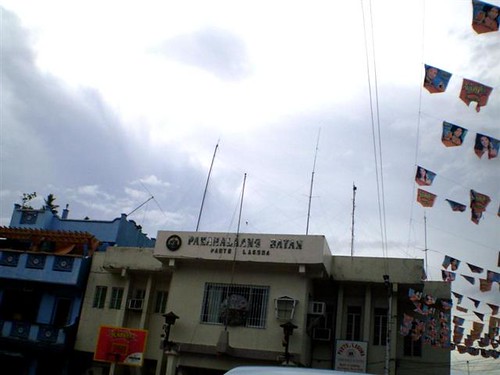
No mistaking, I have indeed arrived in Paete!

Typical colonial arrangement, the plaza is situated near the Parish church
Parish of St. James the Apostle
Otherwise known as...
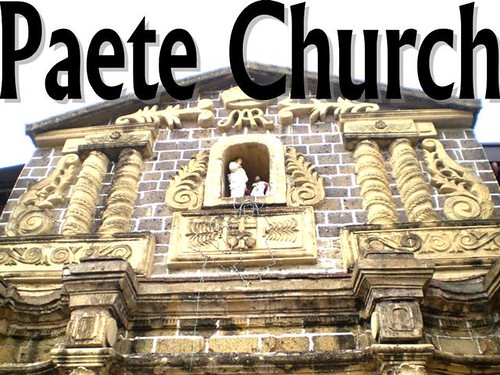
History of the Church
Paete Church (also known as St. James the Apostle Church) is located in Paete, Laguna. St. James the Apostle is the patron of this church built in a town famous for its woodcarvers. In 1580, Juan de Palesencia, a Franciscan friar built a friary in Paete. Its stone church and its convent were built in 1846. In 1717, Rev. Francisco de la Fuente led the construction of a stronger church, which was later destroyed by the earthquake of 1880. The church was reconstructed in 1884 by Rev. Pedro Galiano which was filled with century-old paintings and woorden statuaries. It was destroyed by an earthquake on 20 August 1937 and has since been rebuilt. Paete Church blends a distinctly local style with Western baroque style. All the religious images were carved and/or painted by the residents of Paete long ago. It was completed in the early Spanish period, with a magnificent baroque altar, intricately carved images and 19th century murals by local artist Jose Dans. Although the church has been recently renovated, and the construction materials are not like the original, the designs remain mainly the same. The church is symmetrically organized and compact, with apertures limited to the entrance, choir loft windows, and the circular pediment windows. The ornamentation consists of floral bas-reliefs and acanthus leaves. A relief of Saint James treading on the bodies of dead pagans provide a focus which braids the floral ornamentation together. The triangular pediment has a trim of small ornamental volutes. The bell tower has arched windows and these peek out of the bell tower, rising in tapering tiers. A balustrade is carved on the windows around each level, topped by an octagonal belfry with small, slanting buttresses. Each side features a companile window and the bell tower cornice is a decorative terracotta screen.
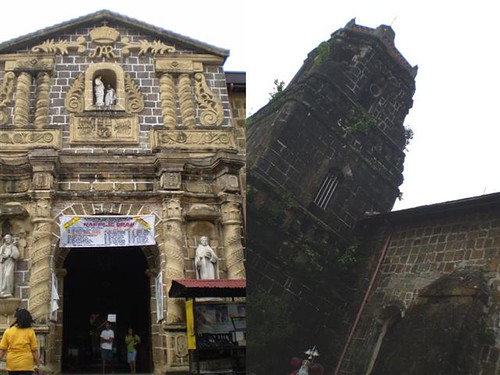
The church has many entrances, am confused...not sure if this is the main entrance or the one on the other side...

Inside the Church, from L-R: The large paintings inside the church were executed by Luciano Dans—these are a series of painting representing Langit, Lupa, Impiyerno (Heaven, Earth, Hell); the main retablo and the main aisle

The main retablo
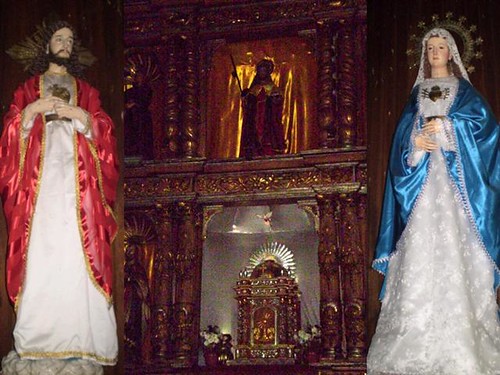
St. James the Apostle, flanked by the image of the Twin Hearts
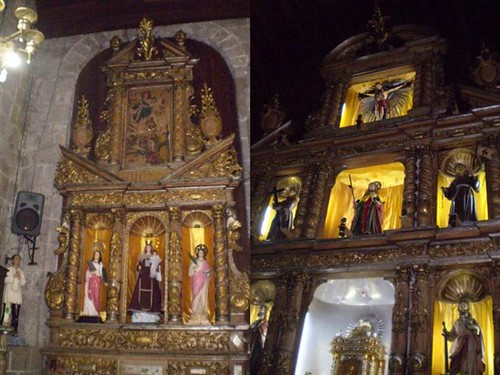
Left side altar and the Main retablo
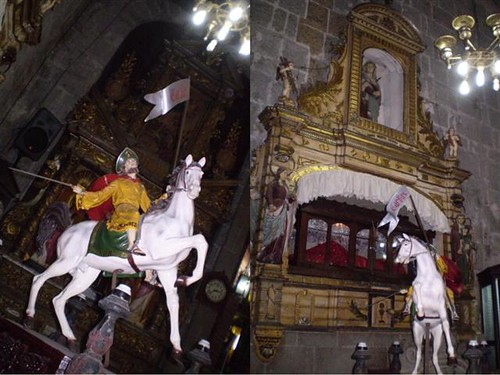
St. James Matamoros

A handsome image of St. Lawrence Martyr
Lawrence of Rome (c. 225 – 258) (Latin: Laurentius, meaning "laurelled") was one of the seven deacons of ancient Rome who were martyred during the persecution of Valerian in 258.
After the Pope Sixtus’martyrdom the prefect of the city, knowing the rich offerings which the Christians put into the hands of the clergy, demanded the treasures of the Roman Church from Lawrence, their guardian. The Saint promised to show him, at the end of three days, riches exceeding all the wealth of the empire. He was granted the time of delay. The Archdeacon of Rome went about assembling the poor, the infirm, and the religious who lived by the alms of the faithful, and he brought them to the prefect on the appointed day. “Behold the treasures I promised you; I add pearls and precious stones — these virgins and widows consecrated to God; the Church has no other riches.” The prefect replied: “How dare you play games with me, miserable one? Is this how you show your contempt for the imperial power?”
Christ, whom Lawrence had served in His poor, gave him strength in the conflict which ensued. After being placed on the rack, he was stretched on a grill over a slow fire. He joked about his pains. “I am roasted enough on this side,” he said, “perhaps you should turn me over.” Soon, his gaze towards heaven, he gave up his soul to God. He was buried in the catacomb near the Tiburtine Way, called the Verano Field, a little over a mile from the city walls. The faithful watched there for three days to mourn their holy Archdeacon who had been so good to them. God, by the glory of this holy martyr, demonstrates the value He sets upon love for the poor. Innumerable prayers were offered at his tomb. Saint Lawrence continued from his throne in heaven his charity to those in need, granting them, as Saint Augustine says, “the smaller graces which they sought, and leading them to the desire of better gifts.” Saint Lawrence, Deacon and Martyr
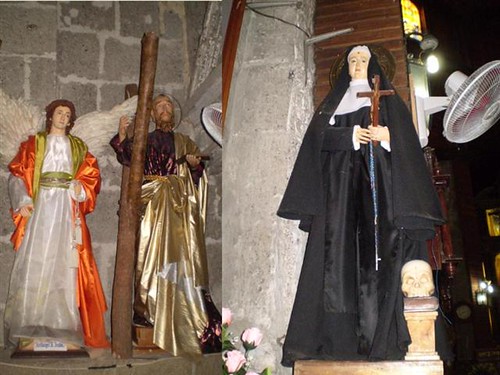
From L-R: Archangel Sealtiel and St. Andrew; St. Rita de Cascia
St Sealtiel carries an incenser, symbol of the prayers & offering of the Divine Sacifice of the Mass, only through the actions of the ordained.
"And another angel came and stood before the altar, having a golden censer; and there was given him much incense, that he should offer of the prayers of all saints upon the golden altar, which is before the throne of God. And the smoke of the incense of the prayers of the saints ascended up before God from the hand of the angel." Apoc 8:3-4

A place for the Choir and another side altar
The Wood Carving Shops of Paete
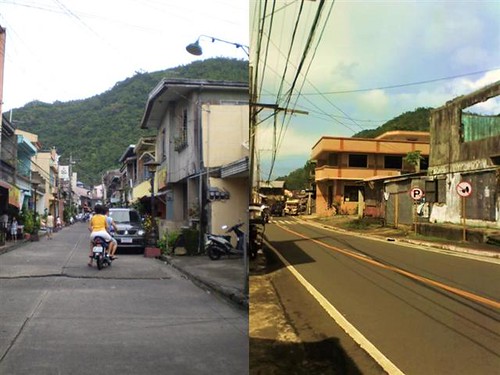
Wood carving shops are scattered all over Paete, some are along the main road while others are a bit hidden, you'll have to take one of the small streets branching from the main road. Like I said, these shops are scattered all over the town good thing it's relatively quite small.
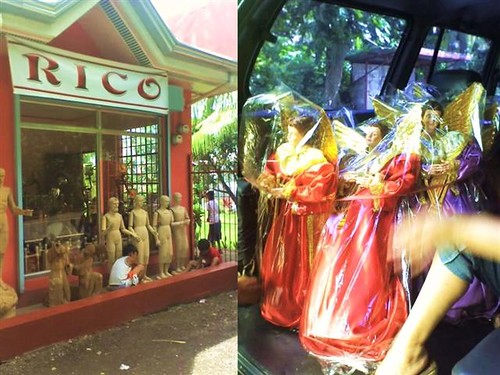
From L-R: One of the shops along the main thoroughfare; a set of papier-mache angels we have already bought. Paete has also ventured outside religious images producing items made from other materials eg papier mache, resin formed into masks, party decors and other decorative figurines--highly commercialized
The Workshop of Paloy Cagyat
This is the biggest workshop I have seen so far, somehow I assume that the old "talleres" during the Spanish occupation were as big and as busy as this shop.
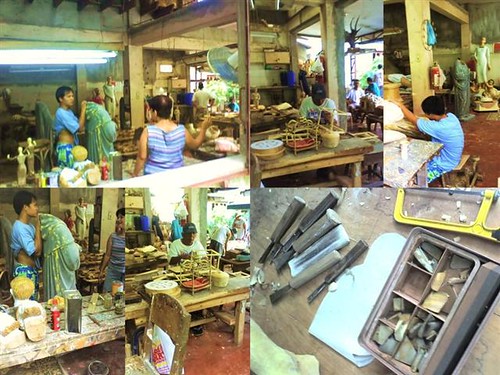
Peeping through the workshop's large windows, the whole shop is a nice work place, airy with high ceilings, well-lit and spacious and the best part is, people are free to roam around the shop and interact with everyone and everything in it...how cool is that; see workers busy with with different tasks
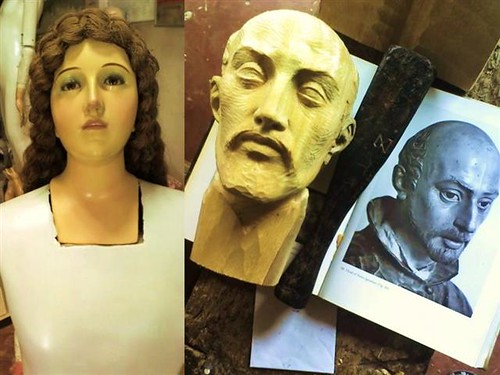
From L-R: An unknown Santa or perhaps an image of the Blessed Virgin; an image of St. Ignatius de Loyolo in its rough, inital stages of carving

The carver's set of tools, a different chisel size to enable the artist to achieve different lines, shapes and depths...in short details; don't miss the glue
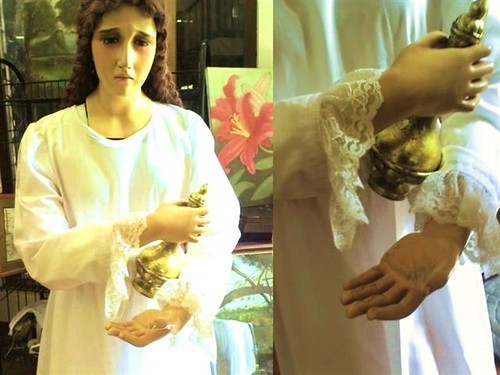
An image presumable of St. Mary Magdalene or of St. Mary of Bethany due to the flask or bottle it is holding
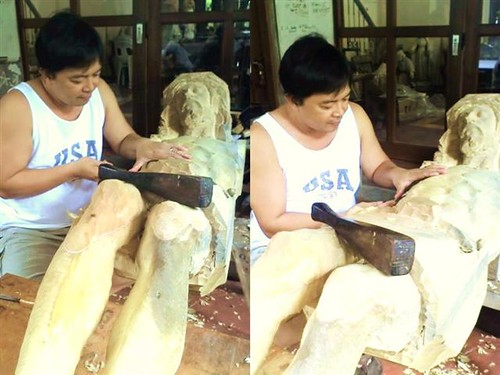
Smoothing the surface the wood, working on an image of the crucifixion
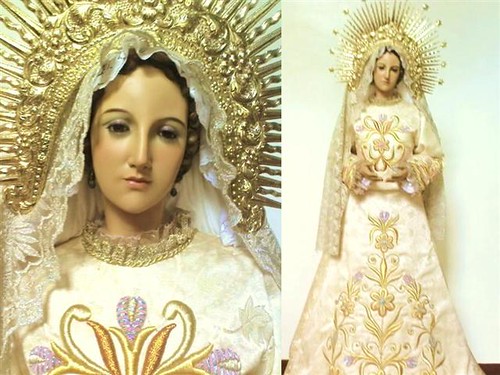
A beautiful Alegria, family owned
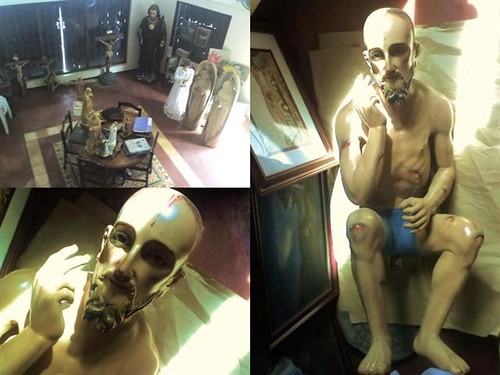
From L-R: Inside Paloy Cagyat's show room; an image of Jesus de la Paciencia
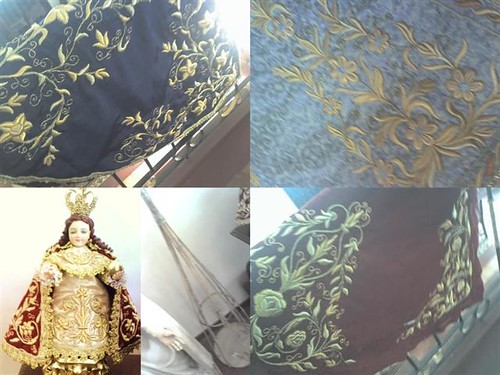
Aside from wood carving, the family has expanded into other santo-related business, on display are garments embroidered by Paloy's wife and relatives.
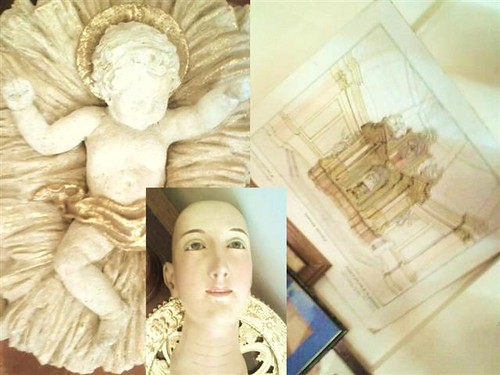
From L-R: Image of the newborn Christ and possible another image of the Blessed Virgin; design of an altar, upon closer inspection looks like the main altar of the Shrine of Our Lady of the Abandoned in Marikina.
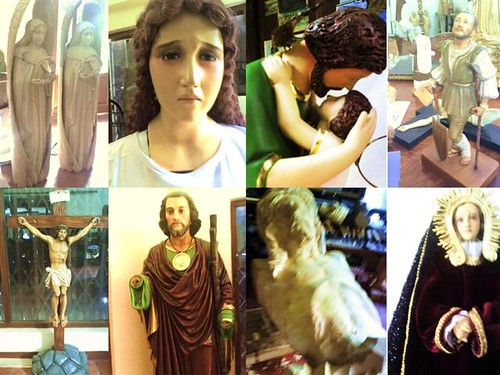
Other images inside the showroom: of angels, saints, and the holy family...
No shortage of Artisans
A tip to interested santo buyers, move around Paete before settling with your choice of artist. The town is relatively small, compared to Pampanga and it is easy for one to visit all the stores (some are close to each other given that most are shops branching out from one lineage) within the day. This is a must to ensure that you settle for someone whom you know will be able to deliver what you are looking for. This is of course the advantage of working with the artist or the carver directly compared to just buying it ready-made.

From L-R: An image of the Dolorosa and St. Peter; an angel suitable atop a carroza or adorning an altar; Bottom: The Three Kings
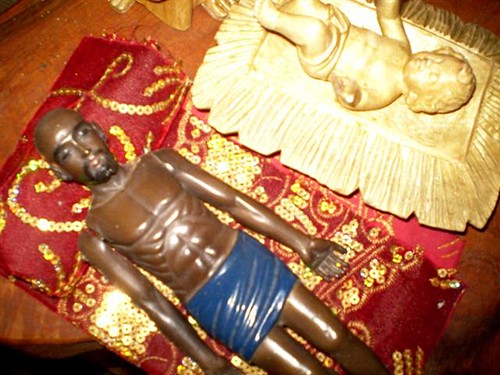
Life and Death, the Messianic purpose of Jesus Christ: Two images of Christ lying down, one as a baby in a manger (the Nativity); and the other after his death on the cross (Santo Entierro)
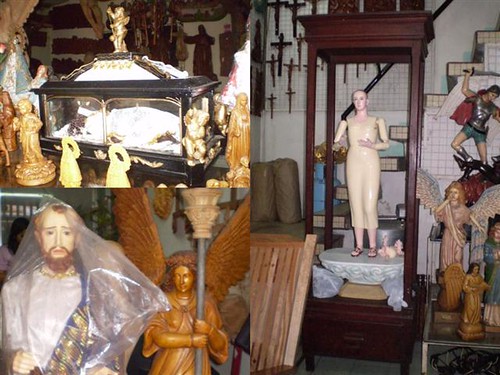
Santo's on display in another shop. It is important to get a feel of the carver's work and how he works. This is an important part which should never be missed before proceeding with a santo project.Paete is a 4th class municipality in the province of Laguna, Philippines. The town is located at the northeastern part of Laguna, along the shores of picturesque Laguna de Bay. It was founded in 1580 by Spanish friars Juan de Plasencia and Diego de Oropesa of the Franciscan Order. It is believed that the earliest inhabitants were of Malay lineage, coming all the way from Borneo in their swift and sturdy boats called "Balangay". The town is made famous by craftsmen highly skilled in woodcarving and its embellishment.
Know more about Paete

No mistaking, I have indeed arrived in Paete!

Typical colonial arrangement, the plaza is situated near the Parish church
Parish of St. James the Apostle
Otherwise known as...

History of the Church
Paete Church (also known as St. James the Apostle Church) is located in Paete, Laguna. St. James the Apostle is the patron of this church built in a town famous for its woodcarvers. In 1580, Juan de Palesencia, a Franciscan friar built a friary in Paete. Its stone church and its convent were built in 1846. In 1717, Rev. Francisco de la Fuente led the construction of a stronger church, which was later destroyed by the earthquake of 1880. The church was reconstructed in 1884 by Rev. Pedro Galiano which was filled with century-old paintings and woorden statuaries. It was destroyed by an earthquake on 20 August 1937 and has since been rebuilt. Paete Church blends a distinctly local style with Western baroque style. All the religious images were carved and/or painted by the residents of Paete long ago. It was completed in the early Spanish period, with a magnificent baroque altar, intricately carved images and 19th century murals by local artist Jose Dans. Although the church has been recently renovated, and the construction materials are not like the original, the designs remain mainly the same. The church is symmetrically organized and compact, with apertures limited to the entrance, choir loft windows, and the circular pediment windows. The ornamentation consists of floral bas-reliefs and acanthus leaves. A relief of Saint James treading on the bodies of dead pagans provide a focus which braids the floral ornamentation together. The triangular pediment has a trim of small ornamental volutes. The bell tower has arched windows and these peek out of the bell tower, rising in tapering tiers. A balustrade is carved on the windows around each level, topped by an octagonal belfry with small, slanting buttresses. Each side features a companile window and the bell tower cornice is a decorative terracotta screen.

The church has many entrances, am confused...not sure if this is the main entrance or the one on the other side...

Inside the Church, from L-R: The large paintings inside the church were executed by Luciano Dans—these are a series of painting representing Langit, Lupa, Impiyerno (Heaven, Earth, Hell); the main retablo and the main aisle

The main retablo

St. James the Apostle, flanked by the image of the Twin Hearts

Left side altar and the Main retablo

St. James Matamoros

A handsome image of St. Lawrence Martyr
Lawrence of Rome (c. 225 – 258) (Latin: Laurentius, meaning "laurelled") was one of the seven deacons of ancient Rome who were martyred during the persecution of Valerian in 258.
After the Pope Sixtus’martyrdom the prefect of the city, knowing the rich offerings which the Christians put into the hands of the clergy, demanded the treasures of the Roman Church from Lawrence, their guardian. The Saint promised to show him, at the end of three days, riches exceeding all the wealth of the empire. He was granted the time of delay. The Archdeacon of Rome went about assembling the poor, the infirm, and the religious who lived by the alms of the faithful, and he brought them to the prefect on the appointed day. “Behold the treasures I promised you; I add pearls and precious stones — these virgins and widows consecrated to God; the Church has no other riches.” The prefect replied: “How dare you play games with me, miserable one? Is this how you show your contempt for the imperial power?”
Christ, whom Lawrence had served in His poor, gave him strength in the conflict which ensued. After being placed on the rack, he was stretched on a grill over a slow fire. He joked about his pains. “I am roasted enough on this side,” he said, “perhaps you should turn me over.” Soon, his gaze towards heaven, he gave up his soul to God. He was buried in the catacomb near the Tiburtine Way, called the Verano Field, a little over a mile from the city walls. The faithful watched there for three days to mourn their holy Archdeacon who had been so good to them. God, by the glory of this holy martyr, demonstrates the value He sets upon love for the poor. Innumerable prayers were offered at his tomb. Saint Lawrence continued from his throne in heaven his charity to those in need, granting them, as Saint Augustine says, “the smaller graces which they sought, and leading them to the desire of better gifts.” Saint Lawrence, Deacon and Martyr

From L-R: Archangel Sealtiel and St. Andrew; St. Rita de Cascia
St Sealtiel carries an incenser, symbol of the prayers & offering of the Divine Sacifice of the Mass, only through the actions of the ordained.
"And another angel came and stood before the altar, having a golden censer; and there was given him much incense, that he should offer of the prayers of all saints upon the golden altar, which is before the throne of God. And the smoke of the incense of the prayers of the saints ascended up before God from the hand of the angel." Apoc 8:3-4

A place for the Choir and another side altar
The Wood Carving Shops of Paete

Wood carving shops are scattered all over Paete, some are along the main road while others are a bit hidden, you'll have to take one of the small streets branching from the main road. Like I said, these shops are scattered all over the town good thing it's relatively quite small.

From L-R: One of the shops along the main thoroughfare; a set of papier-mache angels we have already bought. Paete has also ventured outside religious images producing items made from other materials eg papier mache, resin formed into masks, party decors and other decorative figurines--highly commercialized
The Workshop of Paloy Cagyat
This is the biggest workshop I have seen so far, somehow I assume that the old "talleres" during the Spanish occupation were as big and as busy as this shop.

Peeping through the workshop's large windows, the whole shop is a nice work place, airy with high ceilings, well-lit and spacious and the best part is, people are free to roam around the shop and interact with everyone and everything in it...how cool is that; see workers busy with with different tasks

From L-R: An unknown Santa or perhaps an image of the Blessed Virgin; an image of St. Ignatius de Loyolo in its rough, inital stages of carving

The carver's set of tools, a different chisel size to enable the artist to achieve different lines, shapes and depths...in short details; don't miss the glue

An image presumable of St. Mary Magdalene or of St. Mary of Bethany due to the flask or bottle it is holding

Smoothing the surface the wood, working on an image of the crucifixion

A beautiful Alegria, family owned

From L-R: Inside Paloy Cagyat's show room; an image of Jesus de la Paciencia

Aside from wood carving, the family has expanded into other santo-related business, on display are garments embroidered by Paloy's wife and relatives.

From L-R: Image of the newborn Christ and possible another image of the Blessed Virgin; design of an altar, upon closer inspection looks like the main altar of the Shrine of Our Lady of the Abandoned in Marikina.

Other images inside the showroom: of angels, saints, and the holy family...
No shortage of Artisans
A tip to interested santo buyers, move around Paete before settling with your choice of artist. The town is relatively small, compared to Pampanga and it is easy for one to visit all the stores (some are close to each other given that most are shops branching out from one lineage) within the day. This is a must to ensure that you settle for someone whom you know will be able to deliver what you are looking for. This is of course the advantage of working with the artist or the carver directly compared to just buying it ready-made.

From L-R: An image of the Dolorosa and St. Peter; an angel suitable atop a carroza or adorning an altar; Bottom: The Three Kings

Life and Death, the Messianic purpose of Jesus Christ: Two images of Christ lying down, one as a baby in a manger (the Nativity); and the other after his death on the cross (Santo Entierro)

Looking forward to my next visit...


will you pls give me a price for the 5" sta. juana de cuza statue and the specifications pls. thanks.
ReplyDeleteInterested po cell.no.pls
ReplyDelete